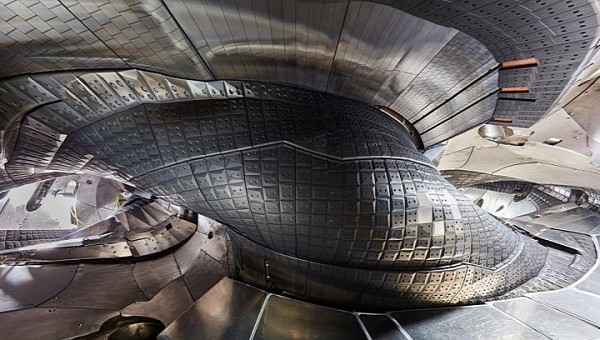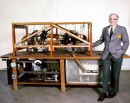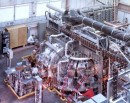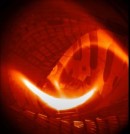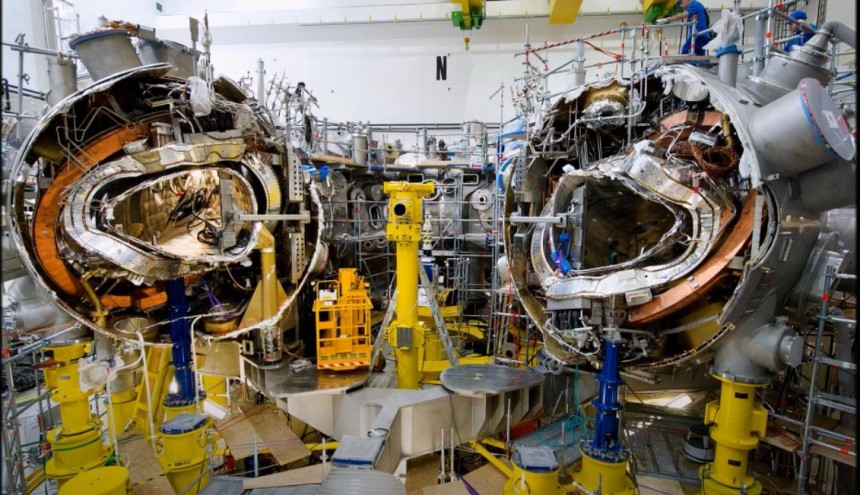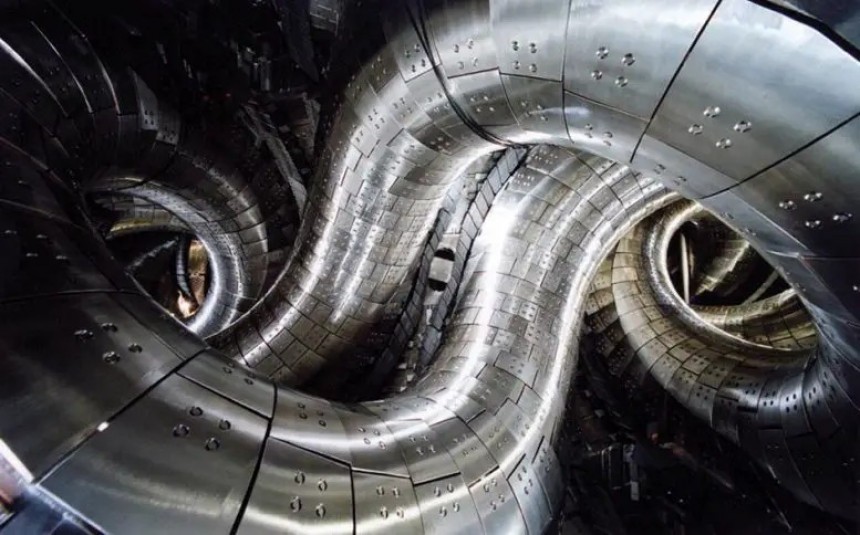Nuclear fusion is nothing new, don't let science fiction movies tell you otherwise. But the key to fusion being commercially viable involves outputting more energy from a fusion reaction than was required to induce the reaction in the first place. The Soviets had their own methods of doing this. But then again, so did the Americans.
Most fusion enthusiasts are familiar with the tokamak-class reactor of Soviet origin. They're perhaps most famous for their use in the UK's Joint European Torus (JET) laboratory and the ITER facility in Southern France. But to understand why stellarators and tokamaks took the forms they did, we need to know the history behind the primordial days of human-produced fusion.
Even if most of us aren't nuclear physicists, we can at least identify the basic nuts and bolts of nuclear fusion as demonstrated by both American and Soviet technology. In simple terms, very light atoms get smashed together with immense pressure and heat to form novel, heavier elements with the motherload of hopefully harvestable energy left over. It's the same process that fuels every star in the universe.
As far back as 1934, a group of three scientists, Mark Oliphant, Paul Harteck, and Ernest Rutherford, used a rudimentary particle accelerator machine similar to that of a stellarator or a tokamak to smash atoms of deuterium into lithium foil. Keep in mind the team had no computers to aid this process. Though primitive on many levels, the working theory behind its operation was no-less groundbreaking.
By the end of World War II, several British physicists were experimenting with micro-scale electromagnetic confinement, as was first proposed by Sir George Paget Thomson of the Imperial College in London. Diving even further, we find that ex-German nuclear scientists fled en masse to Argentina after the war. Scientists like Ronald Richter were employed by Argentine President Juan Domingo Perón to design a stellarator-like device on a remote island near the border with Chile.
Skipping to the year 1951, the stellarator reactor's inventor and Toledo, Ohio native Lyman Spitzer Jr, is taking a phone call from his father detailing Ronald Richter's experiments. Experiments, which, keep in mind, were being dubiously touted by the Argentine press as having achieved sustainable fusion plasma and scientific breakeven. Accolades that wouldn't be confirmed as successful until the 2020s by American scientists in Livermore, California, not Argentina.
As one of the post-WWII-era's brightest minds in plasma physics and star formation, Spitzer took one good look at the newspaper report from Argentina and knew it was bogus. That said, this news got Spitzer's considerably powerful mind jogging about how he could take Ronald Richter's idea and make it more plausible. Being that he was packing for a ski trip at the time of his father's phone call, Spitzer spent his time waiting on ski lifts breaking down the nuts and bolts of his new idea in his head.
All the while, Soviet engineers Igor Tamm and Andrei Sakharov were hard at work with their tokamak design. One of the key issues with fusion reactors which Spitzer wished to solve included a phenomenon called atom drift. In this, ionized atoms of plasma inside a tokamak reactor tend to deviate in their orbits around a perfectly circular fusion core as the temperature and pressure inside the core increase.
In experiments with Spitzer's first number-eight-shaped fusion reactor, he found that pre-fusion plasma tended to maintain a more stable flow with a handful of corners and chicanes mixed in. I.e., the laws of physics appear to prefer Formula One to NASCAR. The results of the American and Soviet research on the matter birthed two profoundly different-looking fusion reactors. The famous donut-shaped torus native to the tokamak is no doubt visually pleasing. That's especially true with a brilliant ring of infernally hot plasma forced to run through it using powerful electromagnets and a central power transformer.
The requirement of such massive, powerful electromagnets makes tokamaks by far the largest form of a fusion reactor. That's why the tokamak that will power ITER in 2025 is 30 meters (98 feet) tall and weighs north of 25,000 US tons (23,000 metric tons). As unapologetically Soviet in origin as tokamak-class reactors are, the American equivalent is similar in working principles. But unlike tokamaks, stellarator reactors, as invented by Lyman Spitzer, could be magnitudes smaller and also many magnitudes more like squiggly line-adjacent.
The deliberately twisted and curvy construction of a stellarator made for a reactor which, in theory, prevented most of the atomic drift associated with tokamaks by working on the same physics as a car losing kinetic energy when entering a tight turn. This, plus portability by itself wouldn't be enough to keep tokamak reactors from being the favored design globally. Starting in the 1960s, research groups around the world, North America included, began to take the same "no replacement for displacement" philosophy that'd define the American auto industry in the same decade.
Meaning, of course, people figured bigger reactors must be better. Spitzer appealed to the United States Atomic Energy Commission to fund his designs. All the while, he employed famous astrophysicist and nuclear engineers like James Van Allen to help manufacture more tabletop-scale stellarator reactors. The first of these machines was completed in 1953.
In subsequently upgraded prototypes with larger, more powerful magnets, Spitzer found the mounts on which the magnets were fastened tended to flex and shift as the current flowing through the device increased. Think of it almost like a worn-down motor mount on your car that makes the engine shake when you rev it. Speaking of car-related items, one variant of Spitzer-designed stellarators, the B-65, used an entirely new plasma flow layout dubbed the "racetrack" configuration.
So then, the Formula One quip from before hits home even harder. The Princeton Plasma Physics Laboratory (PPPL) in New Jersey played host to these achievements starting in the late 50s and early 60s. By 1961, Spitzer had stepped down from the leader of PPPL's stellarator program. With his successor Melvin B. Gottlieb at the helm, Princeton scientists unveiled their ultimate stellarator, the Model C. Making the most out of what was learned from the tabletop-sized Model A and Model B, the Model C was considerably larger. Operation began on the Model C in March 1962.
Even in its largest form, the Model C stellarator is visibly far smaller than the equivalent research-grade tokamaks of the day. In the end, the downfall of the Model C had nothing to do with its design. In an era when the Apollo flight computer undergoing testing to put men on the Moon only had enough RAM to measure in words, not bytes, the hardware simply wasn't available to fine-tune the Model C's fusion core to undergo sustainable fusion.
With that, stellarator-class reactors soon faded into obscurity. Especially after top-secret Soviet tokamak technology was de-classified and licensed off to universities and research groups across Europe, Asia, Australia, and the United States. As if by cruel irony, the Model C stellarator itself was re-engineered into a torus-shaped tokamak reactor in 1969.
As we're all aware, humanity today lacks the gross deficit in computing power it had in the 60s. If anything, the exact opposite is the case. With microchips of ever-increasing power on ever-shrinking sizes, the human race has more than enough power to make stellarators viable once more. Proof-positive of this is the Wendelstein 7-X located at the Max Planck Institute for Plasma Physics in Greifswald, Germany.
Completed in 2015, the W7-X recently finished a series of comprehensive upgrades in the fall of 2022. But with a major radius of 18 feet (5.5 meters), W7-X isn't the largest stellarator. That title belongs to the Large Helical Device built-in Gifu, Japan, in 1998. To say the inside of that reactor looks like you inserted yourself into a tokamak and dropped a tab of some strong hallucinogen would be an understatement. No, seriously, looking at the internals of the thing almost gave us vertigo.
After the National Ignition Facility in California achieved 1.5 times breakeven with a laser-based fusion core in 2022, it's been a two-horse race between stellarators and tokamaks to see which will be the second to break even. Even 25 years ago, experts would have likely told you that tokamaks are the slam-dunk choice over stellarators. But nowadays, the race is so much closer than even Lyman Spitzer might have realized.
A quarter century after his death in 1997, perhaps the most underappreciated theoretical physicist in American history might be about to be vindicated and placed very deservingly in the history books sometime very soon. This is doubly the case if his brainchild manages to achieve scientific breakeven before any of the tokamaks, which experts claimed to be superior in the first place.
Check back soon for more awesome nuclear fusion profiles here on autoevolution.
Even if most of us aren't nuclear physicists, we can at least identify the basic nuts and bolts of nuclear fusion as demonstrated by both American and Soviet technology. In simple terms, very light atoms get smashed together with immense pressure and heat to form novel, heavier elements with the motherload of hopefully harvestable energy left over. It's the same process that fuels every star in the universe.
As far back as 1934, a group of three scientists, Mark Oliphant, Paul Harteck, and Ernest Rutherford, used a rudimentary particle accelerator machine similar to that of a stellarator or a tokamak to smash atoms of deuterium into lithium foil. Keep in mind the team had no computers to aid this process. Though primitive on many levels, the working theory behind its operation was no-less groundbreaking.
Be they stellarators, tokamaks, or any other Earth-bound fusion reactor, the goal is to do much the same as inside the center of the Sun. Just without the benefit of all that immense gravity. With only 9.8m/s2 worth of force to work with here on Earth, the solution to a chronic lack of gravity is electromagnets of ever-increasing power.
Skipping to the year 1951, the stellarator reactor's inventor and Toledo, Ohio native Lyman Spitzer Jr, is taking a phone call from his father detailing Ronald Richter's experiments. Experiments, which, keep in mind, were being dubiously touted by the Argentine press as having achieved sustainable fusion plasma and scientific breakeven. Accolades that wouldn't be confirmed as successful until the 2020s by American scientists in Livermore, California, not Argentina.
As one of the post-WWII-era's brightest minds in plasma physics and star formation, Spitzer took one good look at the newspaper report from Argentina and knew it was bogus. That said, this news got Spitzer's considerably powerful mind jogging about how he could take Ronald Richter's idea and make it more plausible. Being that he was packing for a ski trip at the time of his father's phone call, Spitzer spent his time waiting on ski lifts breaking down the nuts and bolts of his new idea in his head.
All the while, Soviet engineers Igor Tamm and Andrei Sakharov were hard at work with their tokamak design. One of the key issues with fusion reactors which Spitzer wished to solve included a phenomenon called atom drift. In this, ionized atoms of plasma inside a tokamak reactor tend to deviate in their orbits around a perfectly circular fusion core as the temperature and pressure inside the core increase.
The requirement of such massive, powerful electromagnets makes tokamaks by far the largest form of a fusion reactor. That's why the tokamak that will power ITER in 2025 is 30 meters (98 feet) tall and weighs north of 25,000 US tons (23,000 metric tons). As unapologetically Soviet in origin as tokamak-class reactors are, the American equivalent is similar in working principles. But unlike tokamaks, stellarator reactors, as invented by Lyman Spitzer, could be magnitudes smaller and also many magnitudes more like squiggly line-adjacent.
The deliberately twisted and curvy construction of a stellarator made for a reactor which, in theory, prevented most of the atomic drift associated with tokamaks by working on the same physics as a car losing kinetic energy when entering a tight turn. This, plus portability by itself wouldn't be enough to keep tokamak reactors from being the favored design globally. Starting in the 1960s, research groups around the world, North America included, began to take the same "no replacement for displacement" philosophy that'd define the American auto industry in the same decade.
Meaning, of course, people figured bigger reactors must be better. Spitzer appealed to the United States Atomic Energy Commission to fund his designs. All the while, he employed famous astrophysicist and nuclear engineers like James Van Allen to help manufacture more tabletop-scale stellarator reactors. The first of these machines was completed in 1953.
So then, the Formula One quip from before hits home even harder. The Princeton Plasma Physics Laboratory (PPPL) in New Jersey played host to these achievements starting in the late 50s and early 60s. By 1961, Spitzer had stepped down from the leader of PPPL's stellarator program. With his successor Melvin B. Gottlieb at the helm, Princeton scientists unveiled their ultimate stellarator, the Model C. Making the most out of what was learned from the tabletop-sized Model A and Model B, the Model C was considerably larger. Operation began on the Model C in March 1962.
Even in its largest form, the Model C stellarator is visibly far smaller than the equivalent research-grade tokamaks of the day. In the end, the downfall of the Model C had nothing to do with its design. In an era when the Apollo flight computer undergoing testing to put men on the Moon only had enough RAM to measure in words, not bytes, the hardware simply wasn't available to fine-tune the Model C's fusion core to undergo sustainable fusion.
With that, stellarator-class reactors soon faded into obscurity. Especially after top-secret Soviet tokamak technology was de-classified and licensed off to universities and research groups across Europe, Asia, Australia, and the United States. As if by cruel irony, the Model C stellarator itself was re-engineered into a torus-shaped tokamak reactor in 1969.
Completed in 2015, the W7-X recently finished a series of comprehensive upgrades in the fall of 2022. But with a major radius of 18 feet (5.5 meters), W7-X isn't the largest stellarator. That title belongs to the Large Helical Device built-in Gifu, Japan, in 1998. To say the inside of that reactor looks like you inserted yourself into a tokamak and dropped a tab of some strong hallucinogen would be an understatement. No, seriously, looking at the internals of the thing almost gave us vertigo.
After the National Ignition Facility in California achieved 1.5 times breakeven with a laser-based fusion core in 2022, it's been a two-horse race between stellarators and tokamaks to see which will be the second to break even. Even 25 years ago, experts would have likely told you that tokamaks are the slam-dunk choice over stellarators. But nowadays, the race is so much closer than even Lyman Spitzer might have realized.
A quarter century after his death in 1997, perhaps the most underappreciated theoretical physicist in American history might be about to be vindicated and placed very deservingly in the history books sometime very soon. This is doubly the case if his brainchild manages to achieve scientific breakeven before any of the tokamaks, which experts claimed to be superior in the first place.
